Prediction of Surface Treatment Effects on the Tribological Performance of Tool Steels Using Artificial Neural Networks
Abstract
1. Introduction
- The brakes, where a consumable brake pad, through the application of a force, slides against the disc brake to suspend the wheel motion [1].
- The clutch assembly, where the clutch disk slides against the pressure plate to disengage power to the drive train, enabling the vehicle to stop, start, or shift gears [2].
- The air conditioning assembly, where the pulley directly attached to the compressor is coupled to the engine crankshaft via two tensioner pulleys and a polymer V-belt. Poor operation of any of the pulleys would result in stoppage of the belt motion, eventually leading to the interruption of the electrical control circuit.
2. Short Literature Review
3. Need for Research
4. Artificial Neural Networks
4.1. General
4.2. Structure of the BPNN
5. Materials and Methods
5.1. Experimental Procedures—Database
5.2. Material Encoding
5.3. Training Algorithms
5.4. Normalization of Data
5.5. BPNN Model Development
5.6. Mathematical Model Validation
6. Results and Discussion
7. Limitations
8. Conclusions
- Wear-related information can be easily presented in a comprehensive manner by the design of wear maps, as derived through the ANN modelling. Wear maps are user-friendly and allow the determination of areas under steady-state wear, which are recommended for use.
- When the operational parameters are evaluated as severe, it is recommended to select different steel grades.
- Higher values of bulk hardness correspond to a more extended steady-state wear region.
- Surface treatment by nitrocarburizing of the hardened steel has a beneficial effect, as it limits the region of non-recommended use.
- For a certain steel grade, the increase of the sliding speed decreases the region of recommended use.
- Nitrocarburizing seems to be more effective in the case of hot working steel grade than in the cases of cold working grades.
Supplementary Materials
Author Contributions
Funding
Acknowledgments
Conflicts of Interest
Abbreviations
| AISI | American Iron and Steel Institute |
| ANNs | Artificial Neural Networks |
| BNNs | Biological Neural Networks |
| BPNNs | Back-Propagation Neural Networks |
| DNNs | Deep Neural Networks |
| HRC | Bulk Hardness |
| HT | Heat Treatment |
| logsig | Log-sigmoid transfer function |
| purelin | Linear transfer function |
| ST | Surface Treatment |
| tansig | Hyperbolic tangent Sigmoid transfer function |
References
- Pantazopoulos, G.; Tsolakis, A.; Psyllaki, P.; Vazdirvanidis, A. Wear and degradation modes in selected vehicle tribosystems. Tribol. Ind. 2015, 37, 72–80. [Google Scholar]
- Psyllaki, P.; Pantazopoulos, G.; Karaiskos, P. Failure mechanisms of an automobile clutch assembly cast iron pressure plate. J. Fail. Anal. Prev. 2012, 12, 16–23. [Google Scholar] [CrossRef]
- Williams, J.A. Engineering Tribology; Oxford University Press: Oxford, UK, 1996. [Google Scholar]
- Pantelis, D.I.; Pantazopoulos, G.; Antoniou, S.S. Wear behavior of anti-galling surface textured gray cast iron using pulsed-CO2 laser treatment. Wear 1997, 205, 178–185. [Google Scholar] [CrossRef]
- Psyllaki, P.; Kefalonikas, G.; Pantazopoulos, G.; Antoniou, S.; Sideris, J. Microstructure and tribological behaviour of liquid nitrocarburised tool steels. Surf. Coat. Technol. 2003, 162, 67–78. [Google Scholar] [CrossRef]
- Karamboiki, C.-M.; Mourlas, A.; Psyllaki, P.; Sideris, J. Influence of microstructure on the sliding wear behavior of nitrocarburized tool steels. Wear 2013, 303, 560–568. [Google Scholar] [CrossRef]
- Rodríguez, G.P.; de Damborenea, J.J.; Vàzquez, A.J. Surface hardening of steel in a solar furnace. Surf. Coat. Technol. 1997, 92, 165–170. [Google Scholar] [CrossRef]
- Gemelli, E.; Gallerie, A.; Caillet, M. Improvement of resistance to oxidation by laser alloying on a tool steel. Scr. Mater. 1998, 39, 1345–1352. [Google Scholar] [CrossRef]
- Katsamas, A.I.; Haidemenopoulos, G.N. Surface hardening of low-alloy 15CrNi6 steel by CO2 laser beam. Surf. Coat. Technol. 1999, 115, 249–255. [Google Scholar] [CrossRef]
- ASM Handbook. Surface Engineering; ASM International: Materials Park, OH, USA, 1996. [Google Scholar]
- Zagonel, L.F.; Alvarez, F. Tool steel ion beam assisted nitrocarburization. Mater. Sci. Eng. A 2007, 465, 194–198. [Google Scholar] [CrossRef]
- Corengia, P.; Walther, F.; Ybarra, G.; Sommadossi, S.; Corbari, R.; Broitman, E. Friction and rolling-sliding wear of DC-pulsed plasma nitrided AISI 410 martensitic stainless steel. Wear 2006, 260, 479–485. [Google Scholar] [CrossRef]
- Mirjani, M.; Shafyei, A.; Ashrafizadeh, F. Plasma and gaseous nitrocarburizing of C60W steel for tribological applications. Vacuum 2009, 83, 1043–1048. [Google Scholar] [CrossRef]
- Mirjani, M.; Mazrooei, J.; Karimzadeh, N.; Ashrafizadeh, F. Investigation of the effects of time and temperature of oxidation on corrosion behavior of plasma nitrided AISI 4140 steel. Surf. Coat. Technol. 2012, 206, 4389–4393. [Google Scholar] [CrossRef]
- Pye, D. Practical Nitriding and Ferritic Nitrocarburizing; ASM International: Materials Park, OH, USA, 2003. [Google Scholar]
- Pantazopoulos, G.A. Tufftriding and tennifer surface treatment. In Encyclopedia of Tribology; Wang, Q.J., Chung, Y.W., Eds.; Springer: Boston, MA, USA, 2013. [Google Scholar]
- Yu, L. Engineering Physical Metallurgy and Heat Treatment; Mir Publishers: Moscow, Russia, 1977. [Google Scholar]
- Torchane, L.; Bilger, P.; Dulcy, J.; Gantois, M. Control of iron nitride layers growth kinetics in the binary Fe-N system. Metall. Mater. Trans. A 1996, 27, 1823–1835. [Google Scholar] [CrossRef]
- Pantazopoulos, G.; Papazoglou, T.; Psyllaki, P.; Sfantos, G.; Antoniou, S.; Papadimitriou, K.; Sideris, J. Sliding wear behaviour of a liquid nitrocarburised precipitation-hardening (PH) stainless steel. Surf. Coat. Technol. 2004, 187, 77–85. [Google Scholar] [CrossRef]
- Pantazopoulos, G.; Psyllaki, P.; Kanakis, D.; Antoniou, S.; Papadimitriou, K.; Sideris, J. Tribological properties of a liquid nitrocarburised special purpose cold work tool steel. Surf. Coat. Technol. 2006, 200, 5889–5895. [Google Scholar] [CrossRef]
- Dong, C.W. Erosion and wear behavior of nitrocarburized DC53 tool steel. Wear 2010, 268, 629–636. [Google Scholar]
- Liu, R.L.; Yan, M.F. Improvement of wear and corrosion resistances of 17-4PH stainless steel by plasma nitrocarburizing. Mater. Des. 2010, 31, 2355–2359. [Google Scholar] [CrossRef]
- Alexandridis, A. Evolving RBF neural networks for adaptive soft-sensor design. Int. J. Neural Syst. 2013, 23, 1350029. [Google Scholar] [CrossRef]
- Armaghani, D.J.; Hajihassani, M.; Mohamad, E.T.; Marto, A.; Noorani, S.A. Blasting-induced flyrock and ground vibration prediction through an expert artificial neural network based on particle swarm optimization. Arab. J. Geosci. 2014, 7, 5383–5396. [Google Scholar] [CrossRef]
- Armaghani, D.J.; Mohamad, E.T.; Narayanasamy, M.S.; Narita, N.; Yagiz, S. Development of hybrid intelligent models for predicting TBM penetration rate in hard rock condition. Tunn. Undergr. Space Technol. 2017, 63, 29–43. [Google Scholar] [CrossRef]
- Pham, B.T.; Bui, D.T.; Pham, H.V.; Le, H.Q.; Prakash, I.; Dholakia, M. Landslide hazard assessment using random subspace fuzzy rules based classifier ensemble and probability analysis of rainfall data: A case study at mu cang chai district, yen bai province (Vietnam). J. Indian Soc. Remote Sens. 2017, 45, 673–683. [Google Scholar] [CrossRef]
- Pham, B.T.; Prakash, I. Evaluation and comparison of logitboost ensemble, fisher’s linear discriminant analysis, logistic regression and support vector machines methods for landslide susceptibility mapping. Geocarto Int. 2017, 34, 316–333. [Google Scholar] [CrossRef]
- Pham, B.T.; Shirzadi, A.; Bui, D.T.; Prakash, I.; Dholakia, M. A hybrid machine learning ensemble approach based on a radial basis function neural network and rotation forest for landslide susceptibility modeling: A case study in the himalayan area, india. Int. J. Sediment Res. 2018, 33, 157–170. [Google Scholar] [CrossRef]
- Pham, B.T.; Prakash, I. Machine learning methods of kernel logistic regression and classification and regression trees for landslide susceptibility assessment at part of himalayan area, India. Indian J. Sci. Technol. 2018, 11, 1–11. [Google Scholar] [CrossRef]
- Ripley, B.D. Pattern Recognition and Neural Networks; Cambridge University Press: Cambridge, UK, 1996; pp. 1–403. [Google Scholar]
- Adeli, H. Neural networks in civil engineering: 1989–2000. Comput. Aided Civ. Infrastruct. Eng. 2001, 16, 126–142. [Google Scholar] [CrossRef]
- Rutherford, K.L.; Hatto, P.W.; Davis, C.; Hutchings, I.M. Abrasive wear resistance of TiN/NbN multi-layers: Measurement and neural network modelling. Surf. Coat. Technol. 1996, 86, 472–479. [Google Scholar] [CrossRef]
- Jones, S.P.; Jansen, R.; Fusaro, R.L. Preliminary investigation of neural network techniques to predict tribological properties. Tribol. Trans. 1997, 40, 312–320. [Google Scholar] [CrossRef]
- Ramesh, R.; Gnanamoorthy, R. Artificial neural network prediction of fretting wear behavior of structural steel, En 24 against bearing steel, En 31. J. Mater. Eng. Perform. 2007, 16, 703–709. [Google Scholar] [CrossRef]
- Srinivasan, V.; Maheshkumar, K.V.; Karthikeyan, R.; Palanikumar, K. Application of probablistic neural network for the development of wear mechanism map for glass fiber reinforced plastics. J. Reinf. Plast. Compos. 2007, 26, 1893–1906. [Google Scholar] [CrossRef]
- Hayajneh, M.; Hassan, A.M.; Alrashdan, A.; Mayyas, A.T. Prediction of tribological behavior of aluminum–copper based composite using artificial neural network. J. Alloys Compd. 2009, 470, 584–588. [Google Scholar] [CrossRef]
- Rashed, F.S.; Mahmoud, T.S. Prediction of wear behaviour of A356/SiCp MMCs using neural networks. Tribol. Int. 2009, 42, 642–648. [Google Scholar] [CrossRef]
- Shabani, M.O.; Mazahery, A. Modeling of the wear behavior in A356–B4C composites. J. Mater. Sci. 2011, 46, 6700–6708. [Google Scholar] [CrossRef]
- Abdelbary, A.; Abouelwafa, M.N.; El Fahham, I.M.; Hamdy, A.H. Modeling the wear of Polyamide 66 using artificial neural network. Mater. Des. 2012, 41, 460–469. [Google Scholar] [CrossRef]
- Stojanovic, B.; Blagojevic, J.; Babic, M.; Velickovic, S.; Miladinovic, S. Optimization of hybrid aluminum composites wear using Taguchi method and artificial neural network. Ind. Lubr. Tribol. 2017, 69, 1005–1015. [Google Scholar] [CrossRef]
- Pillai, N.; Karthikeyan, R.; Davim, J.P. Heat treatment effects on tribological characteristics for AISI A8 tool steel and development of wear mechanism maps using K means clustering and neural networks. Tribol. Mater. Surf. Interfaces 2018, 12, 44–56. [Google Scholar] [CrossRef]
- Zain, A.M.; Haron, H.; Sharif, S. Prediction of surface roughness in the end milling machining using artificial neural network. Expert Syst. Appl. 2010, 37, 1755–1768. [Google Scholar] [CrossRef]
- Malinov, S.; Sha, W. Application of artificial neural networks for modelling correlations in titanium alloys. Mater. Sci. Eng. A 2004, 365, 202–211. [Google Scholar] [CrossRef]
- Bhadeshia, H.K.D.H.; Dimitriu, R.C.; Forsik, S.; Pak, J.H.; Ryu, J.H. Performance of neural networks in materials science. Mater. Sci. Technol. 2009, 25, 504–510. [Google Scholar] [CrossRef]
- Dixit, U.S.; Joshi, S.N.; Davim, J.P. Incorporation of material behavior in modeling of metal forming and machining processes: A review. Mater. Des. 2011, 32, 3655–3670. [Google Scholar] [CrossRef]
- Stojanović, B.; Vencl, A.; Bobić, I.; Miladinović, S.; Skerlić, J. Experimental optimisation of the tribological behaviour of Al/SiC/Gr hybrid composites based on Taguchi’s method and artificial neural network. J. Braz. Soc. Mech. Sci. Eng. 2018, 40, 311. [Google Scholar] [CrossRef]
- Veličković, S.; Stojanović, B.; Babić, M.; Vencl, A.; Bobić, I.; Bognár, G.V.; Vučetić, F. Parametric optimization of the aluminium nanocomposites wear rate. J. Braz. Soc. Mech. Sci. Eng. 2019, 41, 19. [Google Scholar] [CrossRef]
- Chen, S.L.; Wood, R.J.K.; Wang, L.; Callan, R.; Powrie, H.E.G. Wear detection of rolling element bearings using multiple-sensing technologies and mixture-model-based clustering method. Proc. Inst. Mech. Eng. Part O J. Risk Reliab. 2008, 222, 207–218. [Google Scholar]
- Hornik, K.; Stinchcombe, M.; White, H. Multilayer feedforward networks are universal approximators. Neural Netw. 1989, 2, 359–366. [Google Scholar] [CrossRef]
- Asteris, P.G.; Plevris, V. Neural network approximation of the masonry failure under biaxial compressive stress. In Proceedings of the 3rd South-East European Conference on Computational Mechanics—An ECCOMAS and IACM Special Interest Conference, Kos Island, Greece, 12–14 June 2013; Papadrakakis, M., Kojic, I., Tuncer, M., Eds.; [Google Scholar]
- Asteris, P.G.; Kolovos, K.G.; Douvika, M.G.; Roinos, K. Prediction of self-compacting concrete strength using artificial neural networks. Eur. J. Environ. Civ. Eng. 2016, 20, s102–s122. [Google Scholar] [CrossRef]
- Asteris, P.G.; Tsaris, A.K.; Cavaleri, L.; Repapis, C.C.; Papalou, A.; Di Trapani, F.; Karypidis, D.F. Prediction of the fundamental period of infilled rc frame structures using artificial neural networks. Comput. Intell. Neurosci. 2016, 2016, 5104907. [Google Scholar] [CrossRef] [PubMed]
- Asteris, P.G.; Roussis, P.C.; Douvika, M.G. Feed-forward neural network prediction of the mechanical properties of sandcrete materials. Sensors 2017, 17, 1344. [Google Scholar] [CrossRef] [PubMed]
- Asteris, P.G.; Plevris, V. Anisotropic masonry failure criterion using artificial neural networks. Neural Comput. Appl. 2017, 28, 2207–2229. [Google Scholar] [CrossRef]
- Asteris, P.G.; Kolovos, K.G. Self-compacting concrete strength prediction using surrogate models. Neural Comput. Appl. 2018, 31, 409–424. [Google Scholar] [CrossRef]
- Cavaleri, L.; Chatzarakis, G.E.; Di Trapani, F.; Douvika, M.G.; Foskolos, F.M.; Fotos, A.; Giovanis, D.G.; Karypidis, D.F.; Livieratos, S.; Roinos, K.; et al. Surface roughness prediction of electro-discharge machined components using artificial neural networks. In Proceedings of the 5th International Conference on Integrity, Reliability and Failure, Faculty of Engineering/U, Porto, Portugal, 24–28 July 2016. [Google Scholar]
- Cavaleri, L.; Chatzarakis, G.E.; Di Trapani, F.; Douvika, M.G.; Roinos, K.; Vaxevanidis, N.M.; Asteris, P.G. Modeling of surface roughness in electro-discharge machining using artificial neural networks. Adv. Mater. Res. 2017, 6, 169–184. [Google Scholar]
- Bartlett, P.L. The sample complexity of pattern classification with neural networks: The size of the weights is more important than the size of the network. IEEE Transact. Inf. Theory 1998, 44, 525–536. [Google Scholar] [CrossRef]
- Karlik, B.; Olgac, A.V. Performance analysis of various activation functions in generalized MLP architectures of neural networks. Int. J. Artif. Intell. Expert Syst. 2011, 1, 111–122. [Google Scholar]
- Psyllaki, P.; Stamatiou, K.; Iliadis, I.; Mourlas, A.; Asteris, P.; Vaxevanidis, N. Surface treatment of tool steels against galling failure. In MATEC Web of Conferences; EDP Sciences: Les Ulis, France, 2018; Volume 188, p. 4024. [Google Scholar]
- Lourakis, M.I.A. A Brief Description of the Levenberg-Marquardt Algorithm Implemened by Levmar; Hellas (FORTH) Institute of Computer Science Foundation for Research and Technology: Heraklion, Greece, 2005; Available online: http://www.ics.forth.gr/~lourakis/levmar/levmar (accessed on 10 July 2019).
- Delen, D.; Sharda, R.; Bessonov, M. Identifying significant predictors of injury severity in traffic accidents using a series of artificial neural networks. Accid. Anal. Prev. 2006, 38, 434–444. [Google Scholar] [CrossRef] [PubMed]
- Iruansi, O.; Guadagnini, M.; Pilakoutas, K.; Neocleous, K. Predicting the shear strength of rc beams without stirrups using bayesian neural network. In Proceedings of the 4th International Workshop on Reliable Engineering Computing, Robust Design—Coping with Hazards, Risk and Uncertainty, Singapore, 3–5 March 2010. [Google Scholar]
- Asteris, P.G.; Moropoulou, A.; Skentou, A.D.; Apostolopoulou, M.; Mohebkhah, A.; Cavaleri, L.; Rodrigues, H.; Varum, H. Stochastic vulnerability assessment of masonry structures: Concepts, modeling and restoration aspects. Appl. Sci. 2019, 9, 243. [Google Scholar] [CrossRef]
- Asteris, P.G.; Nozhati, S.; Nikoo, M.; Cavaleri, L.; Nikoo, M. Krill herd algorithm-based neural network in structural seismic reliability evaluation. Mech. Adv. Mater. Struct. 2019, 26, 1146–1153. [Google Scholar] [CrossRef]
- Chen, H.; Asteris, P.G.; Armaghani, D.J.; Gordan, B.; Pham, B.T. Assessing dynamic conditions of the retaining wall using two hybrid intelligent models. Appl. Sci. 2019, 9, 1042. [Google Scholar] [CrossRef]
- Asteris, P.G.; Argyropoulos, I.; Cavaleri, L.; Rodrigues, H.; Varum, H.; Thomas, J.; Lourenço, P.B. Masonry compressive strength prediction using artificial neural networks. In Proceedings of the 1st International Conference TMM_CH, Transdisciplinary Multispectral Modelling and Cooperation for the Preservation of Cultural Heritage, Athens, Greece, 10–13 October 2018. [Google Scholar]
- Mohamad, E.T.; Faradonbeh, R.S.; Armaghani, D.J.; Monjezi, M.; Majid, M.Z.A. An optimized ANN model based on genetic algorithm for predicting ripping production. Neural Comput. Appl. 2017, 28, 393–406. [Google Scholar] [CrossRef]
- Asteris, P.G.; Nikoo, M. Artificial bee colony-based neural network for the prediction of the fundamental period of infilled frame structures. Neural Comput. Appl. 2019. [Google Scholar] [CrossRef]
- Apostolopoulou, M.; Douvika, M.G.; Kanellopoulos, I.N.; Moropoulou, A.; Asteris, P.G. Prediction of compressive strength of mortars using artificial neural networks. In Proceedings of the 1st International Conference TMM_CH, Transdisciplinary Multispectral Modelling and Cooperation for the Preservation of Cultural Heritage, Athens, Greece, 10–13 October 2018. [Google Scholar]
- Nikoo, M.; Ramezani, F.; Hadzima-Nyarko, M.; Nyarko, E.K.; Nikoo, M. Flood-routing modeling with neural network optimized by social-based algorithm. Nat. Hazards 2016, 82, 1–24. [Google Scholar] [CrossRef]
- Nikoo, M.; Sadowski, L.; Khademi, F.; Nikoo, M. Determination of damage in reinforced concrete frames with shear walls using self-organizing feature map. Appl. Comput. Intell. Soft Comput. 2017, 2017, 3508189. [Google Scholar] [CrossRef]
- Nikoo, M.; Hadzima-Nyarko, M.; Nyarko, K.E.; Nikoo, M. Determining the natural frequency of cantilever beams using ann and heuristic search. Appl. Artif. Intell. 2018, 32, 309–334. [Google Scholar] [CrossRef]
- Abad, S.V.A.N.K.; Yilmaz, M.; Armaghani, D.J.; Tugrul, A. Prediction of the durability of limestone aggregates using computational techniques. Neural Comput. Appl. 2018, 29, 423–433. [Google Scholar] [CrossRef]
- Koopialipoor, M.; Armaghani, D.J.; Hedayat, A.; Marto, A.; Gordan, B. Applying various hybrid intelligent systems to evaluate and predict slope stability under static and dynamic conditions. Soft Comput. 2018, 23, 5913–5929. [Google Scholar] [CrossRef]
- Pham, B.T.; Khosravi, K.; Prakash, I. Application and comparison of decision tree-based machine learning methods in landside susceptibility assessment at Pauri Garhwal area, Uttarakhand, India. Environ. Process. 2017, 4, 711–730. [Google Scholar] [CrossRef]
- Pham, B.T.; Bui, D.T.; Prakash, I.; Nguyen, L.H.; Dholakia, M. A comparative study of sequential minimal optimization-based support vector machines, vote feature intervals, and logistic regression in landslide susceptibility assessment using gis. Environ. Earth Sci. 2017, 76, 371. [Google Scholar] [CrossRef]
- Ly, H.-B.; Le, L.M.; Duong, H.T.; Nguyen, T.C.; Pham, T.A.; Le, T.-T.; Le, V.M.; Nguyen-Ngoc, L.; Pham, B.T. Hybrid artificial intelligence approaches for predicting critical buckling load of structural members under compression considering the influence of initial geometric imperfections. Appl. Sci. 2019, 9, 2258. [Google Scholar] [CrossRef]
- Koopialipoor, M.; Fahimifar, A.; Ghaleini, E.N.; Momenzadeh, M.; Armaghani, D.J. Development of a new hybrid ANN for solving a geotechnical problem related to tunnel boring machine performance. Eng. Comput. 2019. [Google Scholar] [CrossRef]
- Koopialipoor, M.; Ghaleini, E.N.; Tootoonchi, H.; Armaghani, D.J.; Haghighi, M.; Hedayat, A. Developing a new intelligent technique to predict overbreak in tunnels using an artificial bee colony-based ANN. Environ. Earth Sci. 2019, 78, 165. [Google Scholar] [CrossRef]
- Gordan, B.; Jahed Armaghani, D.; Hajihassani, M.; Monjezi, M. Prediction of seismic slope stability through combination of particle swarm optimization and neural network. Eng. Comput. 2015, 32, 85–97. [Google Scholar] [CrossRef]
- Hasanipanah, M.; Armaghani, D.J.; Amnieh, H.B.; Koopialipoor, M.; Arab, H. A risk-based technique to analyzeflyrock results through rock engineering system. Geotech. Geol. Eng. 2018, 36, 2247–2260. [Google Scholar] [CrossRef]
- Koopialipoor, M.; Nikouei, S.S.; Marto, A.; Fahimifar, A.; Armaghani, D.J.; Mohamad, E.T. Predicting tunnel boring machine performance through a new model based on the group method of data handling. Bull. Eng. Geol. Environ. 2018, 78, 3799–3813. [Google Scholar] [CrossRef]
- Liao, X.; Khandelwal, M.; Yang, H.; Koopialipoor, M.; Murlidhar, B.R. Effects of a proper feature selection on prediction and optimization of drilling rate using intelligent techniques. Eng. Comput. 2019. [Google Scholar] [CrossRef]
- Gordan, B.; Koopialipoor, M.; Clementking, A.; Tootoonchi, H.; Mohamad, E.T. Estimating and optimizing safety factors of retaining wall through neural network and bee colony techniques. Eng. Comput. 2019, 35, 945–954. [Google Scholar] [CrossRef]
- Zhao, Y.; Noorbakhsh, A.; Koopialipoor, M.; Azizi, A.; Tahir, M.M. A new methodology for optimization and prediction of rate of penetration during drilling operations. Eng. Comput. 2019. [Google Scholar] [CrossRef]
- Sarir, P.; Chen, J.; Asteris, P.G.; Armaghani, D.J.; Tahir, M.M. Developing GEP tree-based, neuro-swarm, and whale optimization models for evaluation of bearing capacity of concrete-filled steel tube columns. Eng. Comput. 2019. [Google Scholar] [CrossRef]

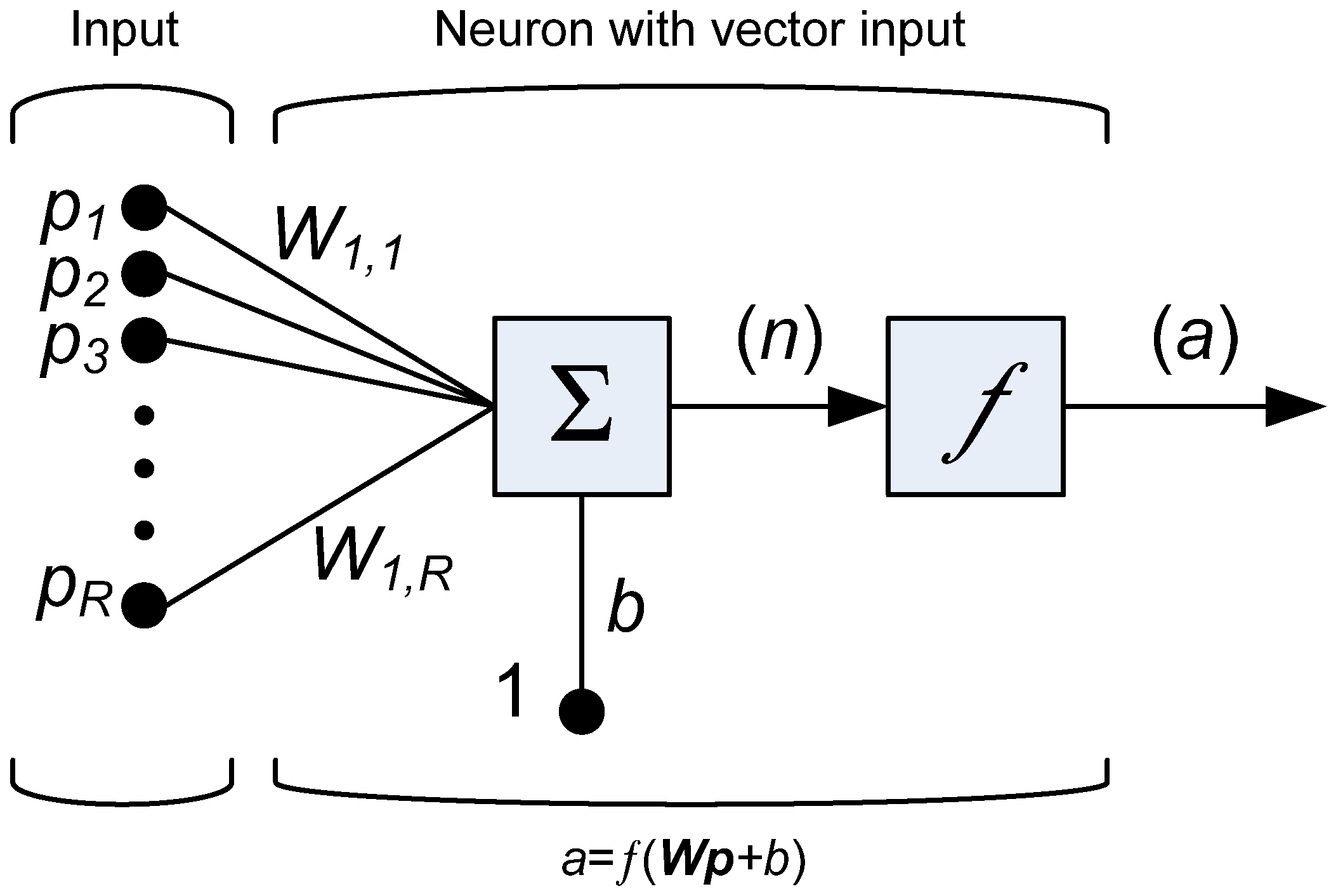
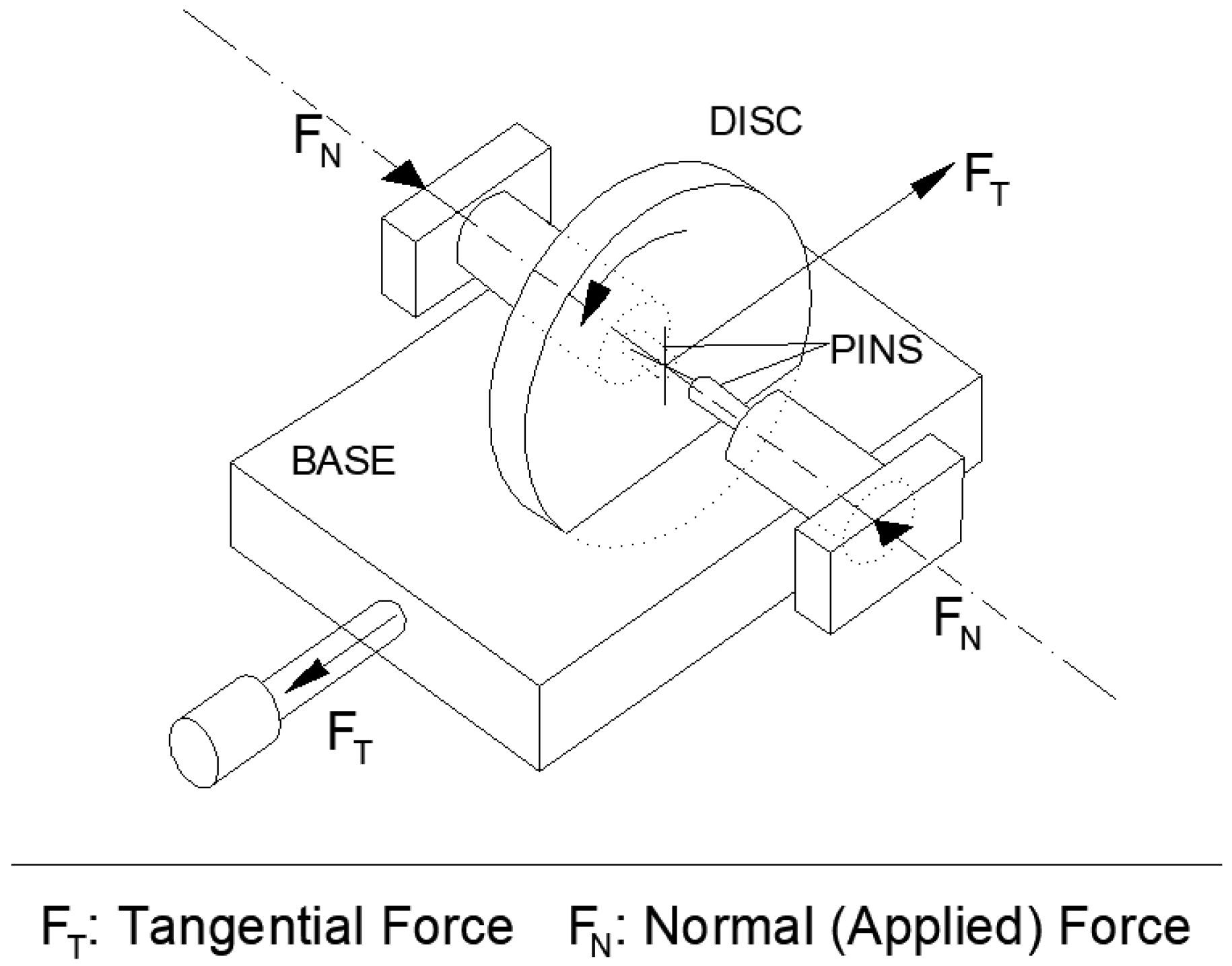
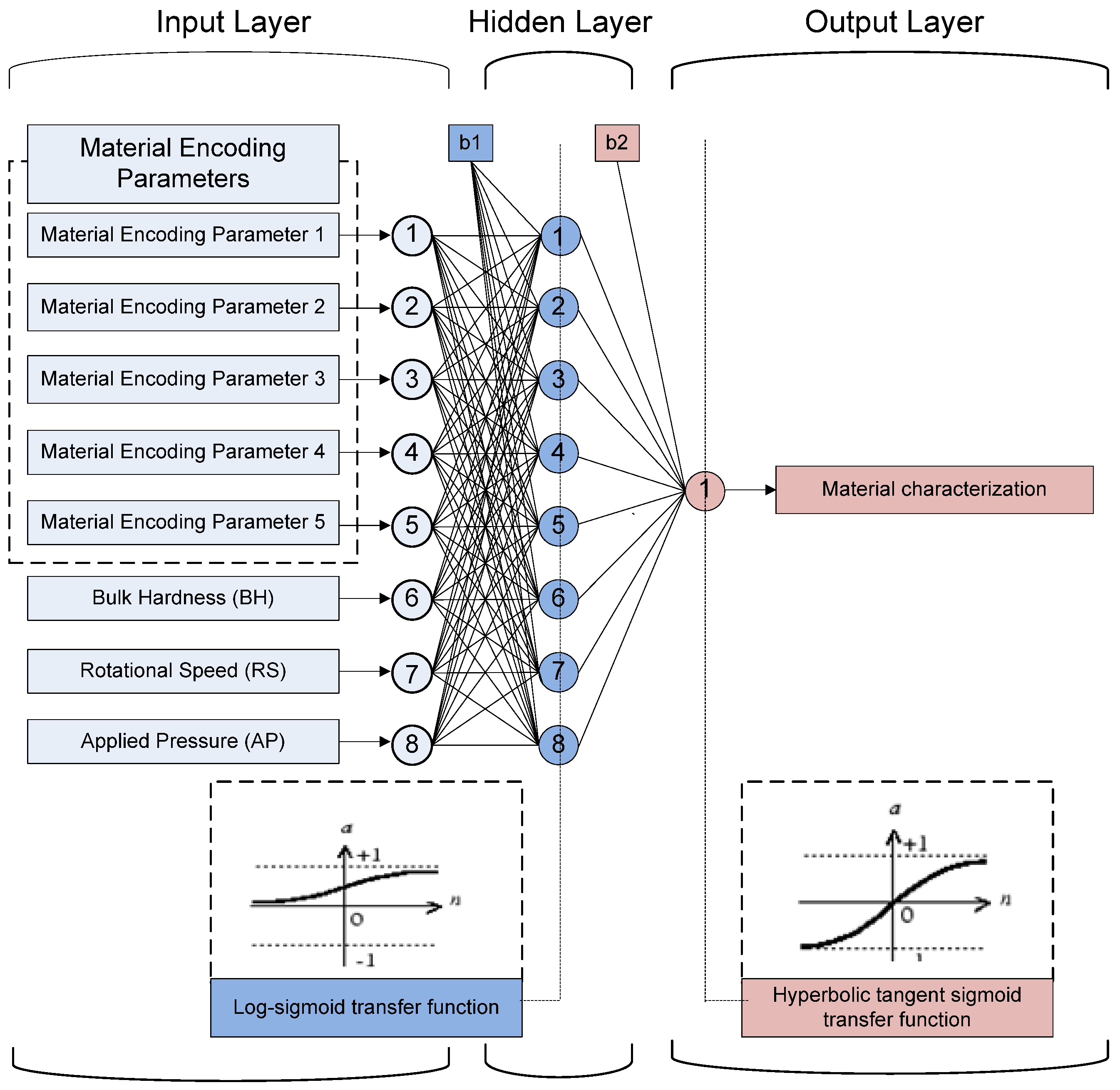
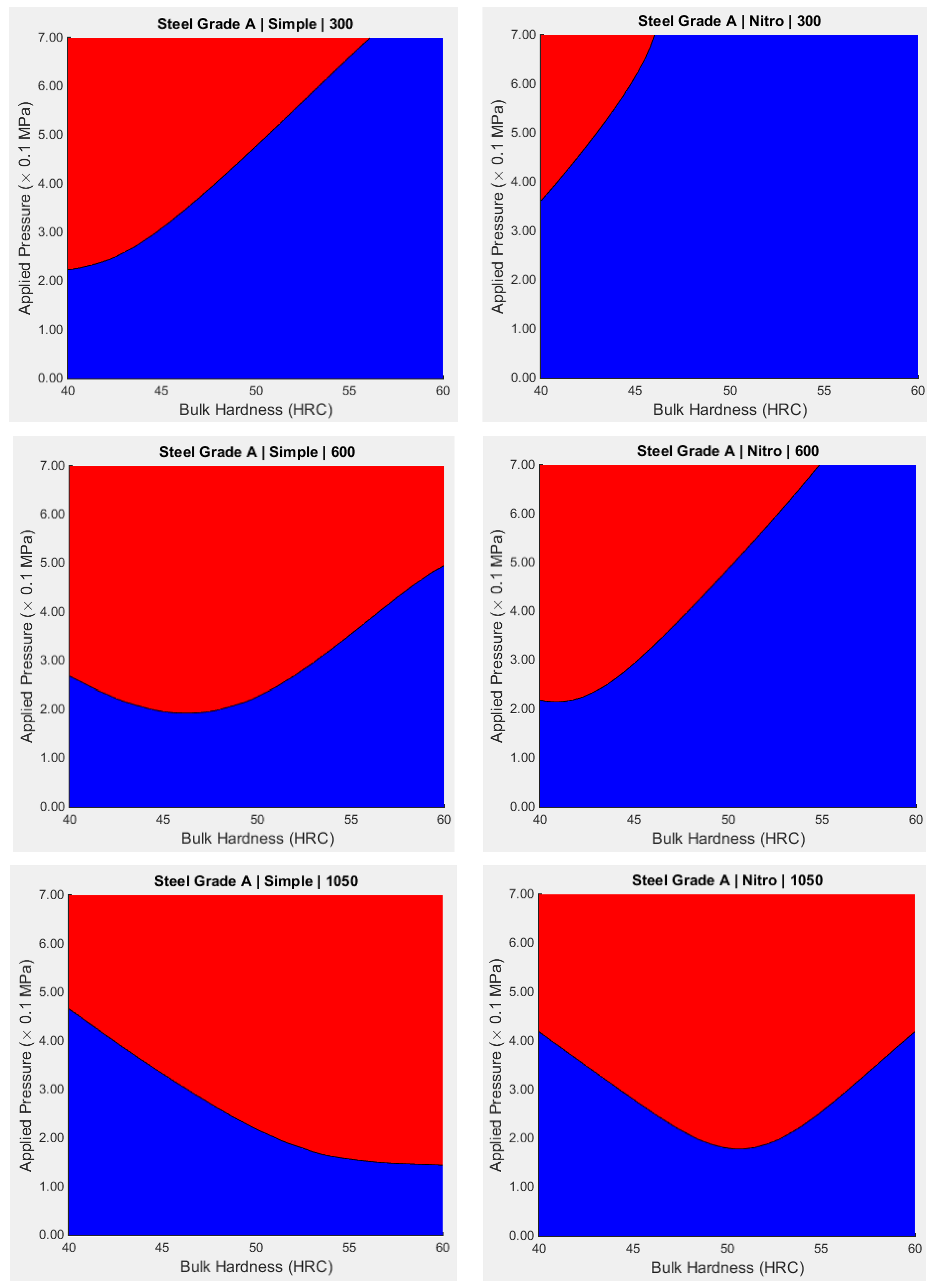
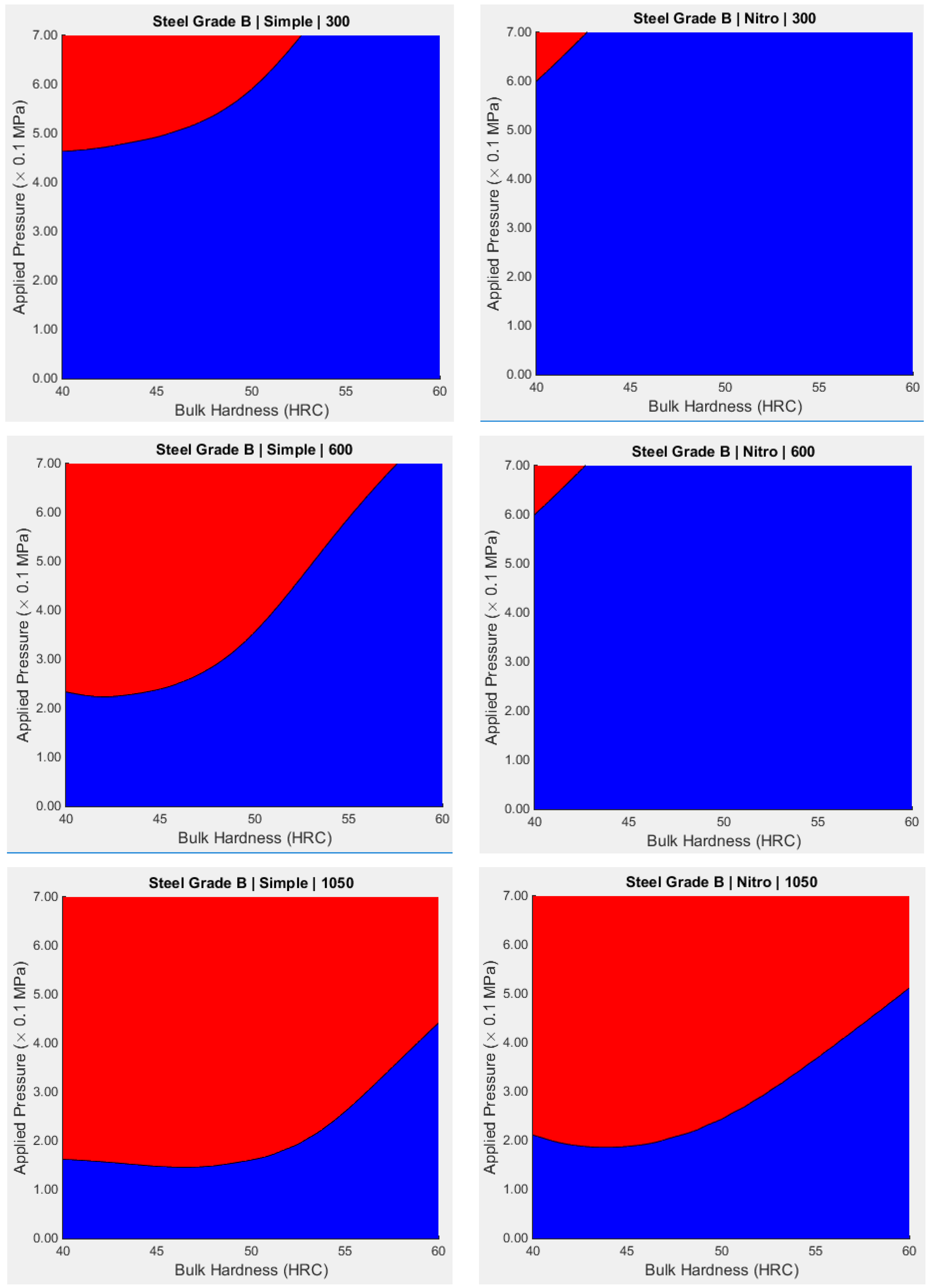
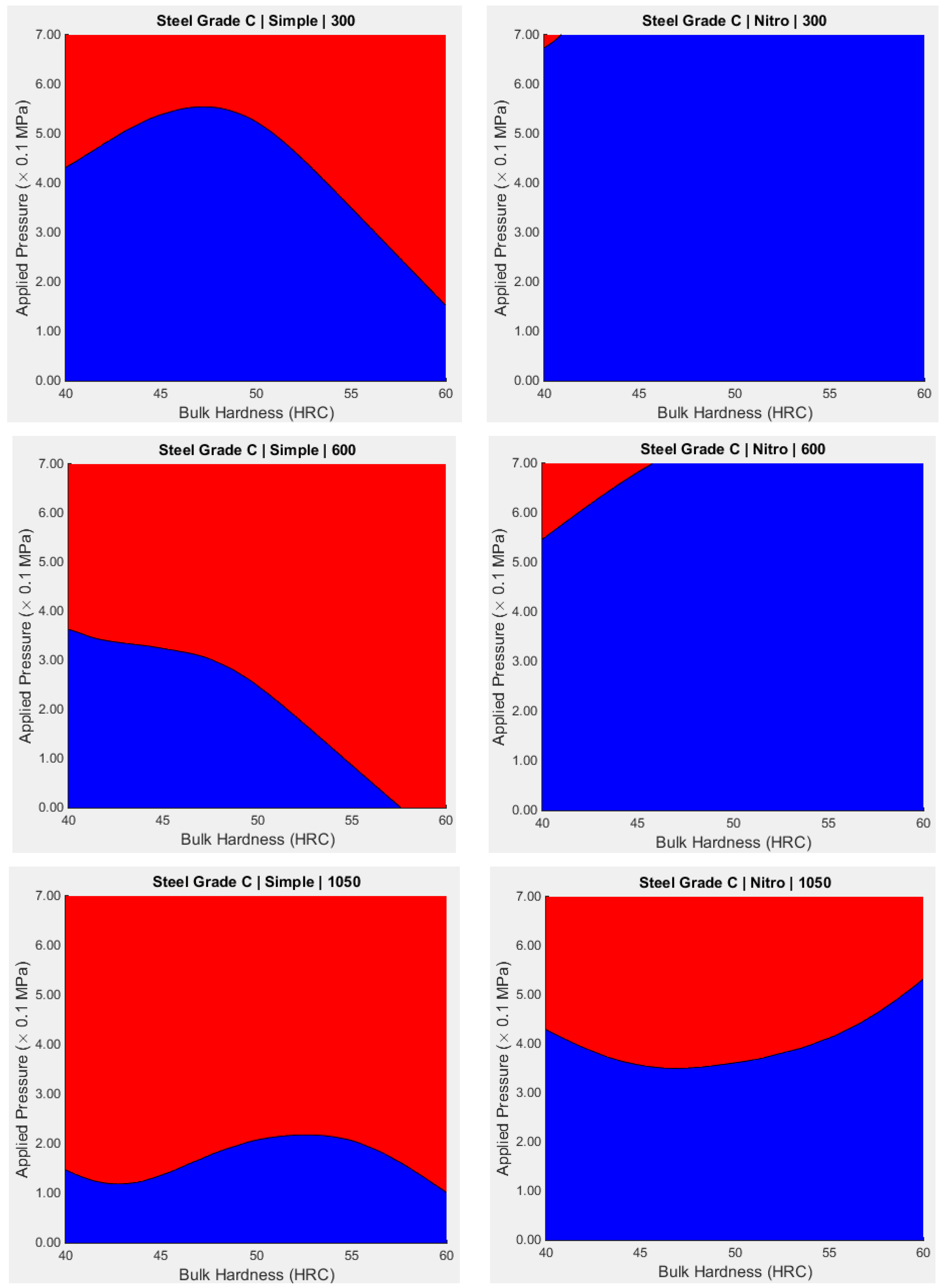
| Material Examined | AISI Classification | Application |
|---|---|---|
| Steel A | D2 | Cold working tools |
| Steel B | - | Cold working tools |
| Steel C | H13 | Hot working tools |
| Wear/Failure Type | Characteristics | Performance of the Tribosystem |
|---|---|---|
| Mode I | Uniform and progressive material loss | Desirable behavior during service |
| Mode II | Galling observed as a sudden increase of the friction coefficient | Non-desirable, due to the incipient interruption of the tribosystem operation |
| Mode III | Plastic flow of the material at the vicinity of the contact, in some cases accompanied by local oxidation | Non-desirable material behavior during application |
| Mode IV | Severe plastic deformation that can be macroscopically observed | Non-desirable material behavior due to the distortion of the mechanical parts |
| Case | Material | Treatment | Encoding Parameters | ||||
|---|---|---|---|---|---|---|---|
| Material | Treatment | ||||||
| I | Steel A | H.T. 1 | 1 | 0 | 0 | 1 | 0 |
| II | H.T. + S.T.2 | 0 | 1 | ||||
| III | Steel B | H.T. | 0 | 1 | 0 | 1 | 0 |
| IV | H.T. + S.T. | 0 | 1 | ||||
| V | Steel C | H.T. | 0 | 0 | 1 | 1 | 0 |
| VI | H.T. + S.T. | 0 | 1 | ||||
| Parameters | Units | Type | Value | |
|---|---|---|---|---|
| No. | Variable | |||
| 1 | Material Encoding Parameter 1 | - | Input | 0 or 1 |
| 2 | Material Encoding Parameter 2 | - | Input | 0 or 1 |
| 3 | Material Encoding Parameter 3 | - | Input | 0 or 1 |
| 4 | Material Encoding Parameter 4 | - | Input | 0 or 1 |
| 5 | Material Encoding Parameter 5 | - | Input | 0 or 1 |
| 6 | Bulk Hardness (BH) | HRC | Input | 40, 50 and 60 |
| 7 | Rotational Speed (RS) | rpm | Input | 0, 300 and 1050 |
| 8 | Applied Pressure (AP) | bar | Input | 0, 3, 5 and 7 |
| 9 | Tribological Performance | - | Output | 0 or 1 |
| Parameter | Value |
|---|---|
| Training Algorithm | Levenberg-Marquardt Algorithm |
| Normalization | Minmax in the range 0.10–0.90 |
| Number of Hidden Layers | 1; 2 |
| Number of Neurons per Hidden Layer | 1 to 30 by step 1 |
| Control random number generation | Rand (seed, generator) where generator ranges from 1 to 10 by step 1 |
| Training Goal | 0 |
| Epochs | 250 |
| Cost Function | MSE 1; SSE 2 |
| Transfer Functions | Tansig (T) 3; Logsig (L) 4; Purelin (P) 5 |
© 2019 by the authors. Licensee MDPI, Basel, Switzerland. This article is an open access article distributed under the terms and conditions of the Creative Commons Attribution (CC BY) license (http://creativecommons.org/licenses/by/4.0/).
Share and Cite
Cavaleri, L.; Asteris, P.G.; Psyllaki, P.P.; Douvika, M.G.; Skentou, A.D.; Vaxevanidis, N.M. Prediction of Surface Treatment Effects on the Tribological Performance of Tool Steels Using Artificial Neural Networks. Appl. Sci. 2019, 9, 2788. https://doi.org/10.3390/app9142788
Cavaleri L, Asteris PG, Psyllaki PP, Douvika MG, Skentou AD, Vaxevanidis NM. Prediction of Surface Treatment Effects on the Tribological Performance of Tool Steels Using Artificial Neural Networks. Applied Sciences. 2019; 9(14):2788. https://doi.org/10.3390/app9142788
Chicago/Turabian StyleCavaleri, Liborio, Panagiotis G. Asteris, Pandora P. Psyllaki, Maria G. Douvika, Athanasia D. Skentou, and Nikolaos M. Vaxevanidis. 2019. "Prediction of Surface Treatment Effects on the Tribological Performance of Tool Steels Using Artificial Neural Networks" Applied Sciences 9, no. 14: 2788. https://doi.org/10.3390/app9142788
APA StyleCavaleri, L., Asteris, P. G., Psyllaki, P. P., Douvika, M. G., Skentou, A. D., & Vaxevanidis, N. M. (2019). Prediction of Surface Treatment Effects on the Tribological Performance of Tool Steels Using Artificial Neural Networks. Applied Sciences, 9(14), 2788. https://doi.org/10.3390/app9142788







